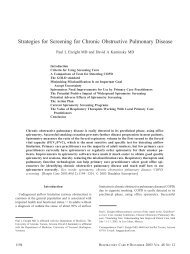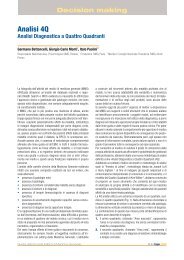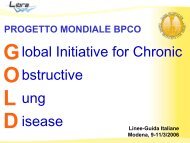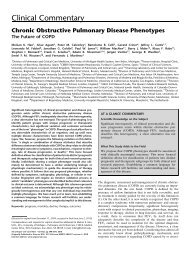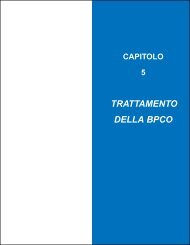Global Initiative for Chronic Obstructive Lung Disease - GOLD
Global Initiative for Chronic Obstructive Lung Disease - GOLD
Global Initiative for Chronic Obstructive Lung Disease - GOLD
Create successful ePaper yourself
Turn your PDF publications into a flip-book with our unique Google optimized e-Paper software.
<strong>GOLD</strong>_WR_05 8/18/05 12:56 PM Page 31<br />
Figure 4-4. Interaction Between<br />
Macrophages, Neutrophils, and Epithelial Cells<br />
• Trans<strong>for</strong>ming growth factor-ß (TGF-ß) and epidermal<br />
growth factor (EGF) show increased expression in<br />
epithelial cells and submucosal cells (eosinophils and<br />
fibroblasts) in COPD patients 33 . These mediators<br />
may play a role in airway remodeling (fibrosis and<br />
narrowing) in COPD 34 .<br />
• Endothelin-1 (ET-1), a potent endothelium-derived<br />
vasoconstrictor peptide, is found at increased<br />
concentrations in induced sputum of patients with<br />
COPD 35 . Patients with severe COPD also have<br />
elevated plasma levels of ET-1, which is probably<br />
related to their chronic hypoxemia 36 .<br />
Cigarette smoke activates macrophages and epithelial<br />
cells to produce tumor necrosis factor- (TNF-),<br />
switching on the gene <strong>for</strong> interleukin-8 (IL-8), which<br />
recruits and activates neutrophils. This process occurs<br />
via the activation of the transcription factor nuclear factor-B<br />
(NF-B).<br />
Printed with permission of Dr. Peter J. Barnes.<br />
Others. Other inflammatory mediators that may be<br />
involved in COPD include the following:<br />
• Macrophage chemotactic protein-1 (MCP-1), a<br />
potent chemoattractant of monocytes, is increased<br />
in the BAL fluid of patients with COPD and smokers<br />
without COPD, but not in ex-smokers or nonsmokers 31 .<br />
Thus, MCP-1 may be involved in macrophage<br />
recruitment into the lungs in smokers.<br />
• Macrophage inflammatory protein-1ß (MIP-1ß) is<br />
increased in the BAL fluid of patients with COPD<br />
compared to smokers, ex-smokers, and nonsmokers 31 .<br />
Macrophage inflammatory protein-1 (MIP-1)<br />
shows increased expression in airway epithelial cells<br />
from COPD patients 3 compared to control smokers.<br />
• Granulocyte-macrophage colony stimulating factor<br />
(GM-CSF) is found at increased concentrations in<br />
the BAL fluid of patients with stable COPD and at<br />
markedly elevated levels during exacerbations 13 . The<br />
number of GM-CSF-immunoreactive macrophages is<br />
also increased in sputum of patients with COPD 32 .<br />
GM-CSF is important <strong>for</strong> neutrophil survival and may<br />
play a role in enhancing neutrophilic inflammation.<br />
• Neuropeptides, such as substance P, calcitonin<br />
gene-related peptide, and vasoactive intestinal<br />
peptide (VIP), have potent effects on vascular function<br />
and mucus secretion. An increased concentration<br />
of substance P is found in sputum of patients with<br />
chronic bronchitis 37 . One bronchial biopsy study<br />
showed an increase in VIP-immunoreactive nerves<br />
in the vicinity of submucosal glands in patients with<br />
chronic bronchitis, suggesting that this substance<br />
may play a role in mucus hypersecretion 38 . However,<br />
another study showed no significant differences in<br />
the number of nerves immunoreactive <strong>for</strong> substance<br />
P, calcitonin gene-related peptide, or VIP between<br />
COPD patients and healthy subjects 39 .<br />
• Complement. Activation of the complement pathway<br />
via generation of the potent chemotaxin C5a may<br />
play a significant role in the neutrophil accumulation<br />
seen in the lungs of patients with COPD 40 .<br />
Differences Between Inflammation<br />
in COPD and Asthma<br />
Although inflammation is important in both diseases,<br />
the inflammatory response in COPD is markedly different<br />
from that in asthma, as summarized in Figure 4-5.<br />
However, some patients with COPD also have asthma,<br />
and the inflammation in their lungs may show characteristics<br />
of both diseases.<br />
Since inflammation is a feature of COPD, it follows that<br />
anti-inflammatory therapies may have clinical benefit in<br />
controlling symptoms, preventing exacerbations, and<br />
slowing the progression of the disease. However, the<br />
inflammatory response in COPD appears to be poorly<br />
responsive to the glucocorticosteroids that are effective<br />
anti-inflammatory medications in asthma.<br />
PATHOGENESIS, PATHOLOGY, AND PATHOPHYSIOLOGY 31


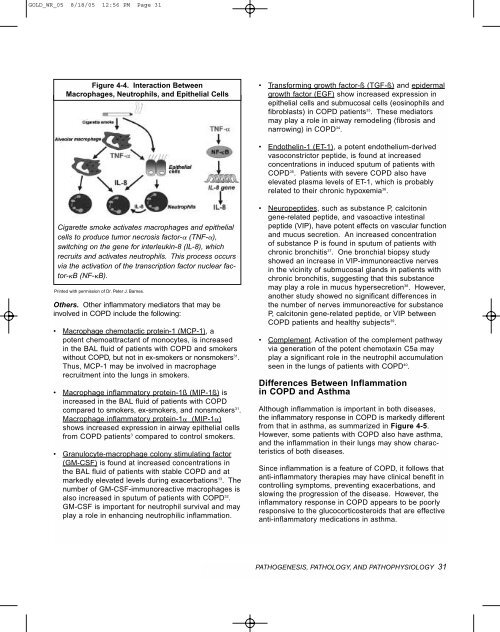
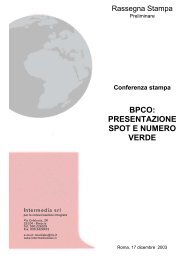
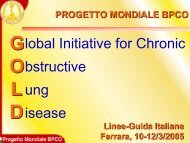
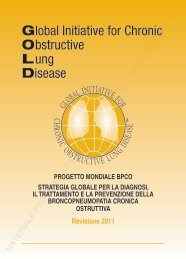
![Di Bari [NO].pdf - GOLD](https://img.yumpu.com/21544924/1/190x143/di-bari-nopdf-gold.jpg?quality=85)


